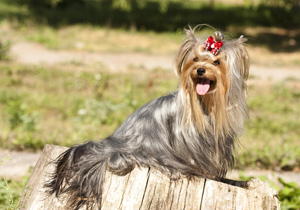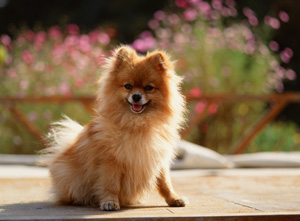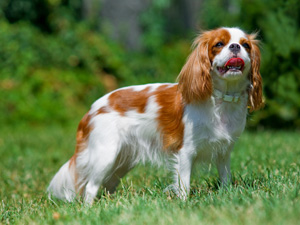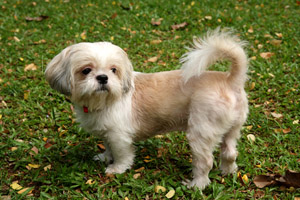Toy Dog Breeds - shih-tzu, yorkshire terrier, maltese, pomeranian, cavalier king charles spaniel and more. Which One is Right for You?
Shih Tzu
Origin
Shih Tzu is believed to trace its ancestry back to the temple dogs of Tibet which had been bred in that country for over 2,000 years. Contact between the rulers of Tibet and China led to several of these dogs being presented as gifts of esteem to Chinese royalty. There, the Lhasa-like dogs were crossed with resident Pekingese to produce the breed we now call the Shih Tzu, meaning "lion dog" in Chinese. The Shih Tzu lived a life of luxury as a pampered palace pet and was not seen outside the court until 1912 when China became a republic. On a visit to China in 1920, General Sir Douglas and Lady Brownrigg saw the breed and brought a pair back to Britain where the Shih Tzu quickly caught the public fancy.
Temperament
The role of companion and housepet is the sole purpose of the Shih Tzu. Its personality is outgoing, affectionate, happy and friendly. Intelligent and docile, the breed readily attracts admirers.
Activity Level
This alert and lively dog carries itself with a distinctly arrogant air. Though the Shih Tzu enjoys a good walk, it does not require a lot of exercise and adapts well to apartment dwelling.
Height and Weight
The ideal height at the withers is about 11 in (28 cm). Mature dogs should weigh from 9-16 lb (4-8 kg).
Coat
The coat is dense, long and flowing. There is also a soft undercoat.
Colour
All colours are acceptable, but black noses, lips and eye rims are a must.
Grooming
Daily brushing is essential.
Yorkshire Terrier

Origin
A far cry from the diminutive glamorous breed of today, early Yorkshire Terriers were developed in the north of England in the mid-19th century for the job of dispatching rats in the coal pits and cotton mills. They were also featured combatants in rat-killing contests. But in those days, the breed was roughly twice the size of today's Yorkies. It's believed the Dandie Dinmont, Black and Tan and Skye Terriers were interbred to produce the original Yorkie. Then a cross to a Maltese reduced the breed in size. About that time, it began to be regarded as a Toy breed rather than a terrier; in 1886 it was given the breed name of Yorkshire Terrier. Breeding the attractive little Yorkies became a cottage industry in Yorkshire when the breed caught the fancy of wealthy ladies. The Yorkie has gone on to become one of the most popular Toy breeds.
Temperament
Even though the Yorkshire Terrier is often a very pampered pet, it is still loaded with spirit and displays its terrier heritage. It does make an alert watchdog.
Activity Level
Playful, bouncy and inquisitive, the Yorkie is an active dog that really doesn't know or care how small he might be. Its exercise needs are minimal, making it a good choice for stay-at-homes or couch potatoes. This is not a breed for small children.
Height and Weight
The dainty dogs should not exceed 7 lb (3 kg) in weight.
Coat
The long body coat is glossy, fine, silky and straight. Hair on the muzzle is very long.
Colour
The coat is steel-blue in colour, with tan head and legs. Pups are born almost black but their coats clear to blue by a year of age.
Grooming
Daily brushing is essential.
Pomeranian

Origin
A true Spitz breed in miniature, the Pomeranian is the smallest member of that family of northern breeds. But that wasn't always the case. The original Pomeranian weighed up to 30 lb (13.5 kg). When the breed was imported to Britain during the reign of Queen Victoria, Her Majesty took an interest in the Poms but preferred a smaller dog weighing 12-18 lb (5.5-8 kg). British breeders took up the challenge and succeeded in reducing the breed even further in size, producing dogs 3-7 lb (1.5-4 kg). The Pom has since become one of the most popular of the Toy breeds. The breed takes its name from Pomerania, once a part of Germany.
Temperament
The extroverted Pomeranian exhibits intelligence and a vivacious spirit. With his docile temper, pert animation and cocky attitude, he is a most appealing pet and companion.
Activity Level
Buoyant, alert and inquisitive, the Pom is an ideal housepet for adults who spend a lot of time indoors. He makes a good watchdog, manages with a minimum of exercise and enjoys being pampered.
Height and Weight
This sturdy little dog may weigh from 3-7 lb (1.5-4 kg) with 4-6 lb (2-3 kg) being considered ideal.
Coat
Over the soft, fluffy undercoat there's a long, perfectly straight and glistening outer coat covering the body. It's abundant around the neck, shoulders and chest where it forms a frill of profuse, off-standing hair.
Colour
Poms come in a variety of colours and colour combinations, which include black, brown, chocolate, beaver, red, orange, cream, orange sable, wolf sable, blue, white and parti-colour.
Grooming
Gentle daily brushing is needed to keep the coat free of mats.
Maltese

Origin
The Maltese is believed to be the oldest European Toy breed. Art objects dating back 3,000 years bear likenesses of the dainty little dogs. The Maltese was described in writings of 200 BC under the Latin name of Canis Melitaeus, which may refer to the island of Malta or to the Sicilian town of Melita. From early times, the breed appears to have been known and admired throughout Europe and often had its portrait painted as it lounged on the laps of aristocratic ladies. It was also well known in Britain at the time of Elizabeth I (1558-1603). Some historians claim the breed was brought by Roman invaders while others theorize returning Crusaders brought the small charmers back as gifts for their ladies.
Temperament
The Maltese is said to be among the gentlest mannered of all little dogs. The breed is intelligent, affectionate and seemingly fearless.
Activity Level
A vigorous canine, the Maltese is always ready for a romp. Its small size makes the Maltese a fine pet for limited accommodations. His exercise needs are minimal.
Height and Weight
The Maltese should weigh under 7 lb (3 kg) with 4-6 lb (2-3 kg) being considered ideal. Height may be up to 10 in (25 cm) at the shoulder.
Coat
The single coat (no undercoat) is flat, silky and hangs straight to the ground from a centre part running from nose to tip of tail.
Colour
The glamorous coat is white. Dark, luminous eyes and pigmentation of nose, lips and eye rims enhance the breed's beautiful expression.
Grooming
That lovely coat needs daily brushing to stay tangle-free and frequent bathing to keep it sparkling white.
Cavalier King Charles

Origin
Once the favourite breed of King Charles II of England, the small sporting spaniel was first dubbed the King Charles Spaniel. Then oriental breeds came into fashion and breeders began crossbreeding the spaniels to achieve a more snub-nosed, round-headed look. In 1926, a wealthy American visited England in search of the small spaniels so often seen in portraits of King Charles. But there were none. So he offered monetary prizes to be awarded at the famed Crufts Dog Show for the male and female most closely resembling the original King Charles Spaniel. British breeders rose to the occasion and by 1945, the recreated breed had arrived. To avoid confusion with the now-snub-nosed King Charles Spaniels, the breed was named the Cavalier King Charles Spaniel since Charles was known as the Cavalier King.
Temperament
Gentle and affectionate with a happy, sporting and fearless nature, the Cavalier is known as a wonderful companion. Indeed the breed was known as the "Comforter" or the "Spaniel Gentle" in the early days of its history.
Activity Level
Though playful and alert, the Cavalier is a born lapdog whose exercise requirements are easily satisfied. It is relatively quiet and calm-natured.
Height and Weight
The Cavalier stands 12-13 in (30-33 cm) in height and weighs approximately 12-18 lb (5.5-8 kg).
Coat
The coat is long, silky and may have a slight wave. To add to its endearing appearance, the Cavalier carries feathering on the ears, legs, feet and tail.
Colour
Four colour variations are found in the breed. Blenheim is a pearly white background with bright-red-chestnut markings. The tri-colour has jet-black markings on a white background with tan markings over the eyes, on the cheeks, inside the ears, legs and under the tail. Ruby is a whole-coloured rich red. Black-and-tan is jet black with tan markings.
Grooming
The silky coat requires only brushing to keep it neat. No trimming is permitted or needed.
